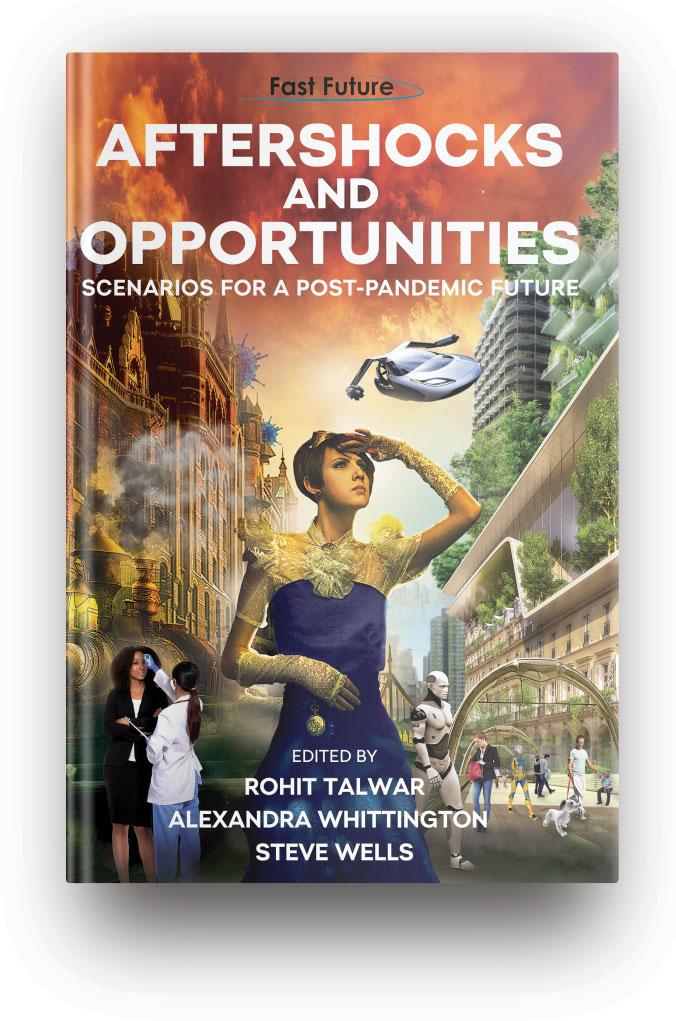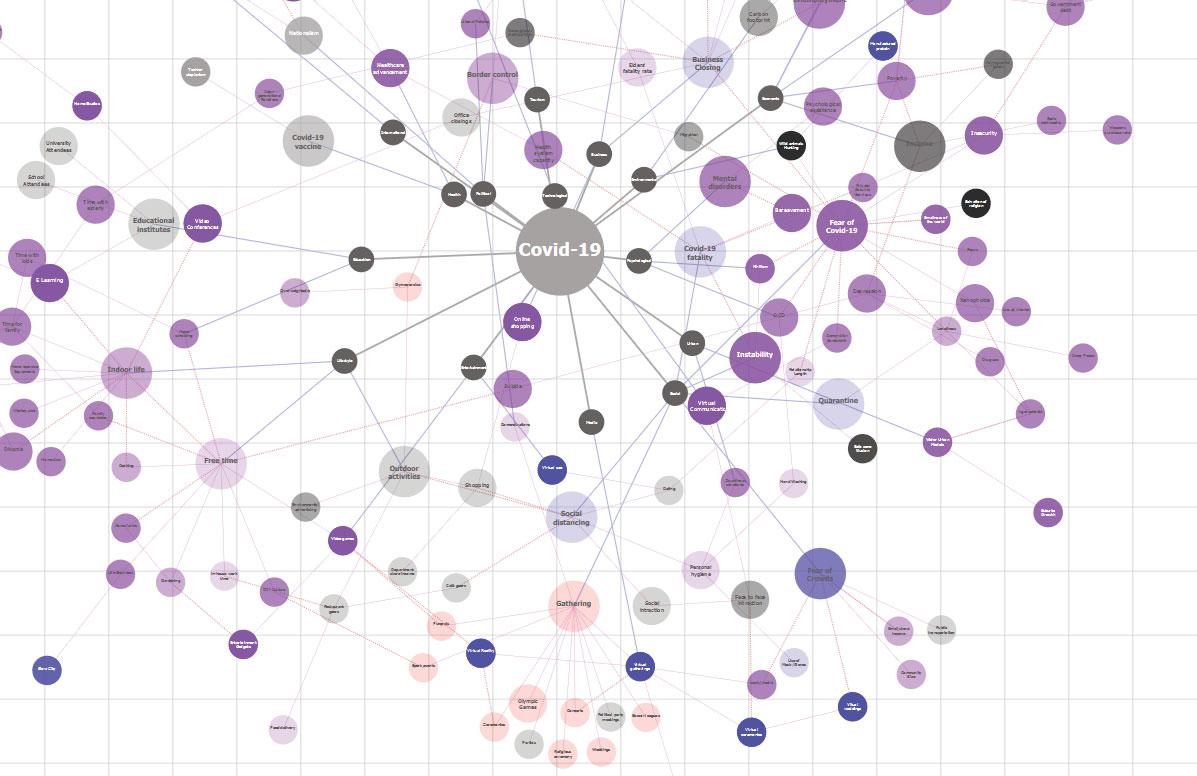
17 minute read
WORLD FUTURE DAY 2020 AND THE MILLENNIUM PROJECT

Mara Di Berardo
Co-Chair Millennium Project Italian Node





WORLD FUTURE DAY 2020 AND THE MILLENNIUM PROJECT
24-hour Round-the-World conversation
World Future Day (WFD) is on March, the fi rst, and the Millennium Project (MP) organized a 24-hour Round-theWorld conversation to celebrate it for the seventh consecutive year. Experts on futures studies, global opinion leaders and the public shared their ideas about how to build a better future in a relaxed, open, no-agenda conversation.
The MP, a global foresight participatory think tank, hosted the 2020 event on the Zoom platform, in collaboration with the Association of Professional Futurists (APF), Humanity+, the UNESCO Global Futures Literacy Network, the World Academy of Art and Science (WASS) and the World Futures Studies Federation (WFSF). Many others promoted and supported the event to stimulate futures thinking. The WFD had 29 facilitators for the various time zones and three administrators, all engaged on a voluntary base.
The conversation about the futures of humanity began on March 1st in New Zealand at 12 noon NZ time, and moved West each hour. When it reached the Central Europe Time, it had a special guest, Vint Cerf, Internet pioneer: he is widely known as one of the fathers of the Internet together with Bob Kahn for co-designing the TCP/IP protocol and the architecture of the Internet. During the 2020 WFD, we also discussed about climate change, participation and communication, education and learning, the Internet, information warfare, next technologies, ethics and markets, and many events, activities, and research reports were shared in the platform chat 1 .
Climate change, with increased level of temperatures, ocean oxygen depletion and acidifi cation, is a very serious longterm problem, said the WFD participants, and infl uences other global challenges, such as balancing population growth and available resources, sustainable and safe energy sources and access to clean water, for instance. The Global Catastrophic Risk Institute is a think tank that analyzes risks to the survival of human civilization and the Lifeboat Foundation helps human survival encouraging technological advance. The City Resilience Program is a partnership between the World Bank and the Global Facility for Disaster Reduction and Recovery for city scale resilience to natural and social disasters, where pandemic risk can be included. These themes will be also addressed during the UN 2020 Ocean Conference in Lisbon, June 2-6.
Meantime, the volume “Under a Green Sky” by Peter Ward (2007) shows how long-range global warming could lead to the next species extinction plant-wide. WFD participants discussed how the Sun could one day have disturbances big enough to destroy us, or collision with a large enough asteroid, or hydrogen sulfi de emissions from future changing ocean conditions, or other species threats, therefore it would be wise to let those who want to migrate beyond the Earth to do so. The Earth’s magnetic fi eld that protects the Earth from most of the solar radiation is weakening (separate from the usual weakening before polar magnetic shifts) but it seems that the Sun and the Earth are entangled, so that as a big fl are occurs, the shape of the fi eld that protects it changes. Human curiosity will take us beyond the solar system: just as we would not know what we are capable of when we were a zygote totally dependent on our mother, we might not know what humanity is capable of until it gets out of its dependency on the Sun and matures into exo-Solar space.
One question that the participants debated in various ways was whether we can have democracy and still address
BIBLIOGRAPHY:
Glenn, J., Florescu, E. (2017), State of the Future 19.1, Library of Congress. Glenn, J. (2019), “Work/Tech 2050. Scenarios and Actions”. Ward, P.D. (2008), “Under a Green Sky: Global Warming, the Mass Extinctions of the Past, and What They can Tell Us About Our Future”, Smithsonian Book.
WEBLIOGRAPHY:
Association of Professional Futurists: https://www.apf.org/ Auroville: https://www.auroville.org/ Copenhagen Institute for Futures Studies reports on fi nancial investments for climate change: https://innovationsfonden.dk/sites/default/fi les/2019-11/climatepanel_fi nal-report-komprimeret.pdf
Idea in Brief
The World Future Day is a 24hours conversation about the futures of humanity, coordinated by the Millennium Project. On the 1st of March 2020, the conversation began in New Zealand at 12 noon time, and moved West each hour. When it reached the Central Europe Time, it hosted Vint Cerf, Internet pioneer, discussing the status of the Internet and information equality and pollution, the sources of information and the need of critical thinking. Others themes of the discussions were climate change, migration beyond the Earth, next technologies, democracy, participation and inclusion, communication, culture, and arts, education and learning, ethics and market economies.
sustainability issues such as climate change in the time that is needed to solve them. It is better to begin now to implement solutions and fi x new problems as they arise. Criminals and corrupt government offi cials will likely enter new lines of activity and will stay one-step ahead of any slow-moving democratic efforts to stop them. In either case, we cannot just throw out old systems, new systems will need to build slowly in parallel to the old ones and will need to continue to support the old systems as they are gradually replaced. As renewable energy systems grow, for instance, old nuclear systems will need to continue to be managed.
Climate change as well as other global challenges facing humanity are more a cultural problem than a technical one, said WFD participants, because there are many solutions for these problems already and others may come. Someone in Australia proposed that seawater coastline agriculture could get money from cap and trade. The algae, one of its outputs, could be feedstock for cell-based pure meat. This would mean three counter global warming strategies into one mega project: saltwater agriculture, meat without animals, and cap and trade. The Global Regeneration Institute already has a library of Global Solutions and the Millennium Project addresses the 15 global challenges facing humanity since 1997. Martin Kruse from the Copenhagen Institute for Futures Studies reports on fi nancial investments for climate change solutions defi ned by the Innovation Fund Denmark’s Climate Solutions Panel. What we lack is the will and global collaboration to act applying these solutions: we are unfortunately not taught to collaborate with different people and ideas.
Together with transparency and accountability, participation is a key concept for collaboration, democratization and collective intelligence and often recurred during the WFD discussion. E2Glats created in Brazil an experimental platform to invent new ways of being and social organizations. Auroville in India is creating a universal sustainable city where men and women can live in peace no matter believes, politics and nationalities. Someone talked about imagining a social network focused on problem solving, forum style, with all kinds of topics people could collaborate on from big topics, like economy and climate, to small topics, like fi xing the holes in a street on our town. Some participants would like to make that happen, with the help of a group of people sharing that vision. On a global scale, this is developing now in the Global Futures Intelligence System by the Millennium Project but others are planning similar platforms, such as the European Commission with the Global Systems Science.
Inclusion is just as fundamental. Some argued that solutions must be drawn from communicating with everyone in a society and that even the United Nations Sustainable Development Goals are being decided by a small group, without input from the rest of humanity they will affect. Others counter argued that UN SDGs was the most extensive set of global conversations including NGOs, business, academia as well as government representatives, that took place over several years about goals for humanity that has ever occurred. They granted there were small groups but there were many, and to give the impression that the process was just a small group misrepresents what happened and denigrates the evolution of global participatory history.
Communication is another major theme discussed during WFD, especially for inclusion. Many of the people who will be most greatly affected by such major changes futurists anticipate are people who have had the least to say about the causes of problems or about the potential solutions to the problems, including indigenous populations, the poor, the illiterate, women, and the young. Futurists report increasing use of the arts, including simple picture making but also self-made videos, Virtual Reality (VR) games, making and listening to music together, and even dance. Some are asking young people to make their own videos about the future in order to reveal hidden beliefs, fears or desires, which they fi nd diffi cult to communicate otherwise. Others are using VR and cell phones to tag individual trees and other objects in a Talking Forest to help people understand changes in the environment.
Arts can change culture and public will as well. A key variable in The Millennium Project “Work/Technology 2050. Scenarios and Actions” (Glenn, 2019) is collaboration with writers of music, movies, and TV. If Al Gore got an academy award for a PowerPoint presentation on global warming, what could collaborative talent do in Hollywood? Tiny Revolutions in New Zealand uses the 15 Global Challenges facing humanity as a framework to engage groups of artists, industry experts, activists and members of the public to come up with and implement “bite-sized actions that pack a societal punch”. Kickstarter and future similar platforms are new ways to get support for new projects.
Education and learning should make human more intelligent, knowledgeable and wise enough to address global challenges facing humanity. Someone suggested that the very nature of thinking might change with the widespread use of quantum computing: from digital binary, black/white simplistic thinking to both/and thinking, so that we could collectively act for climate change instead of individually doing so. Educational systems should not only teach STEM (Science, Technology, Engineering and Mathematics) or STEAM (with Arts) but also creativity, arts and shared values, educating to democratic values, equality, tolerance, peace and civic sense.
Education and learning should also train in critical thinking, said Vint Cerf, so that people can recognize disinformation and fraudulent courses of information. We should all learn to evaluate what we see: algorithms by themselves can fail to identify disinformation but humans in cooperation with AI algorithms can do better. Where the algorithms cannot, critical thinking could help us: asking questions, corroborating evidence and rational analysis similarly to the scientifi c process, combining empirical evidence and common sense. Scientifi c process is the best approximation of reality we have. Citizen science, where the public takes part to the scientifi c process with various degrees of participation, could help develop critical thinking by learning contents of research and how the scientifi c process works.
Quality of democracies worldwide depends on information quality received by the public (Glenn, Florescu, 2017). Unfortunately, not everybody is at ease in a well-informed society: we often reject information that does not match our worldview even if true and believe disinformation if it matches our worldview. We are going through a great Turing Test - said Vint Cerf during the WFD, - as we are not being able to tell the difference between computergenerated disinformation and human generated truth. Information warfare manipulates information channels trusted by a target without the target's awareness, so that the target will make decisions against their interest but in the interest of the one conducting information warfare. Algorithms are not perfect and we need metrics to balance loss of information, fragmentation of knowledge with needs to delete damaging information for public safety.
Identifying the source of information is diffi cult. Much can be done without governments to address the problem but international agreements are needed to defi ne norms guiding behaviors on the Internet and penalties for those causing damages through disinformation. The private sector can conduct predictive analytics with massive databanks of disinformation, listing potential actions to counter before they happen, and match people’s profi les with requirement to counter the actions similar to how people’s profi les are matched with advertiser’s products. Certifi cation systems of authorities could be launched but they could be compromised in the system and in who produces them. If we do not implement adequate policies to counter the information warfare and transnational crime, we could end up in a society where boundaries between what
NOTES:
1. Many of the reported events could not take place live following to the COVID-19 worldwide lockdown. 2. Image from https://informationisbeautiful.net/visualizations/ ikigai-japanese-concept-to-enhance-work-life-sense-of-worth/.
BIO:
Mara Di Berardo is Millennium Project Italian Node co-chair and Research Fellow at the Institute for Applied Mathematics of the National Research Council of Italy With inputs from Jerome Glenn, CEO of The Millennium Project, and Brock Hinzmann, Co-chair of the Millennium Project Silicon Valley Node.
is true and what is not fade more and more.
Despite having to address such criticalities, making global information and communication technologies, along with machine intelligence, big data and cloud computing, work for everyone is fundamental, as highlighted during the WFD. Even though the digital divide is shrinking, the usage of applications such as Artifi cial Intelligence is widening. The Internet was launched 50 years ago, in 1969, to connect computer servers and people, and it is beginning to connect places and objects with the Internet of Things (IoT). Vint Cerf confi rmed that the Internet is technically viable even with vast new increasing bandwidth demand. There could be more cost for connecting as we improve technology. While trying to expand a faster and faster internet in every place of the world, some governments try to shut it down and to control and fi lter its contents, with the risk of a network fragmention.
It will be hard to escape the Internet with the advent of 5G anyway, and it includes information pollution. Users can implement fi ltering mechanism to limit the overload and select sources, contents and groups but this is another cause for fragmentation, of knowledge instead of the global open Internet, said Vint Cerf. The WFD conversation also discussed about cyber warfare, that attacks computers, software, command and control systems, and participants

wondered how to make the Internet safer humanity, we could move toward a by improving systems, and how to create new global order deteriorating into a incentives for strong authentication/ combination of nation-states, megaidentifi cation to validate information corporations, local militias, terrorism, sources. Maybe we will also need rules and organized crime (Glenn, 2019), thus about responsibility for our personal AI/ we need to anticipate and act towards Avatars or digital twins after we die. Who possible positive scenarios. Learning Mind is responsible for what they do after we die? What will happen if they commit a cyber-crime or earn a fortune? However, the news “ broadcasts the worst human behavior every day; hence, many think the future is getting worse. Some participants think that it is easier to imagine better future appliances ” than it is to imagine better future humans. Star Trek shows for instance all and Singularity University post optimistic kinds of improved technology but little scenarios and views. The MP “If Humans improvement among humans. One Were Free – the Self-Actualization person noted, on the other hand, that Economy” (Glenn, 2019) scenario is also the 'enemy' in one Star Trek series is positive, and the #happy2050 awareness often added as members of the 'crew' in campaign by the Millennium Project in the next series, which is a sign of social Italy aimed at stimulating positive views progress. Most science fi ction shows at 2050. negative futures anyway. Someone said that we should show videos of We can surely imagine positive respectful discussions within diverse scenarios and act for them but families learning from those with whom not without considering the Next we disagree, instead of watching only Technologies (NT, Glenn, 2019). NTs parliament disrespectful debate without include Artifi cial Intelligence, in its listening to each other. If we do not narrow (ANI), general (AGI) and super address the main challenges facing (ASI) evolutions, and robotics but also
E2Glats: https://www.youtube.com/watch?index=2&v=q6lr18- 2m_s&list=PL96oFrLfqPKpZ_vYNk4oU5fJ8XzEmt0TC&app=deskt op Festival for the future: https://www.festivalforthefuture.org.nz/ Future of Capital: https://futureofcapital.org/ Global Regeneration Institute: http://www.globalregenerationinstitute.com/ Holochain: https://holochain.org/ Humanity+: https://humanityplus.org/ Kickstarter: https://www.kickstarter.com/ Learning Mind scenarios: https://www.learning-mind. com/7-optimistic-scenarios-for-the-future-of-our-planet/ Millennium Project 15 Global Challenges facing humanity: http://www. millennium-project.org/15-global-challenges/ Millennium Project Global Futures Intelligence System: http://www.millenniumproject.org/projects/global-futures-intelligence-system/ Millennium Project Italian node #happy2050 awareness campaign: http://bit. ly/2st88S0 Nordic Wealth Movement: https://iff.dk/initiativer/nordic-health-2030/
synthetic biology and genomics, 3D/4D printing and bio-printing, IoT, human augmented intelligence, telepresence and holographic communications, drones (and other autonomous vehicles), nanotechnology, computational science, VR and AR (Augmented Reality), blockchain, cloud analytics, quantum computing, collective intelligence, and the extraordinary future synergies among them. NTs could led us to be augmented humans living as conscioustechnologies and pursuing selfactualization but they could also lead to a future of social despair if we do not learn how to manage their design, use and evolution. The TransVision Conference in Madrid, October 16-19, will discuss longevity extension, artifi cial intelligence, human enhancement and other technologies and future trends. The Festival for the Future in Wellington, July, 24-26, explores global challenges with CEO’s, entrepreneurs, students, and 1,200+ delegates from across the Asia–Pacifi c.
We urgently need to agree about ethics, says participants to the WFD, especially for the Artifi cial Intelligence evolutions, as recently highlighted by the agreement promoted by the Vatican on the matter. A WFD participant not only warned about the need for governance of future possible AGI but also ANI (as in the National Institute of Standard and Technology new standards for AI). ANI such as autonomous weapons and stock market algorithms could lead to disasters. We have to design system issues and regulations right and soon. Australia is inviting public comments on these AI issues and the Millennium Project is planning to address futures AI evolutions in a next study.
Ethical considerations should become more routinely incorporated into global decisions also to reduce the gap between rich and poor. Participants discussed about potential differences between the north and the south of the world regarding internet and other technologies. For some, these differences are still strong and we need collaboration to activate the south. Bringing technology, norms and standardization or developing capacities without the possibility to live the experience in terms of solutions and strategies is not suffi cient anymore. Divides should be bridged by addressing the global challenges with metaphors, new narratives and a learning dimension making part of the building process. For someone else, inequalities between north and south are less than in the past: the challenges are global and we should understand in which areas we converge, also in order to address them better together.
Ethical considerations could also encourage ethical market economies, maybe following the Japanese ikigai 2 concept suggested during the WFD, a prism for potentially seeing how to bring satisfaction, happiness and meaning to life, “happiness of being busy”. Some said that many prescriptions for change should offer some fi nancial incentive to make a change in behavior, even if others argued that this should not be necessary. Zebras Unite is a global network of entrepreneurs, funders, investors, and allies who are calling for a more ethical, inclusive, collaborative, distributed, and sustainable movement to transform prevailing startup and venture capital culture. Another group that explores new approaches to capital is the Future of Capital initiative, focused on restoring the right relationship between consciousness and capital, as creative force and constructive resource. Holochain aims at being an alternative to blockchain and MetaCurrency explores new concepts of wealth. The Nordic Wealth Movement wants to drive the transition from sick care to preventive health to ensure the longevity of our healthcare systems and improved quality of life.
As highlighted by the WFD discussions and reported within the MP State of the Future 19.1 (Glenn, Florescu, 2017) the global challenges facing humanity during unprecedented accelerating change are interconnected and need collaboration, trans-institutional solutions and participatory decision making integrating improved global foresight in order to be addressed.
Public comments requested in Australia on AI issues: https://www. aph.gov.au/Parliamentary_Business/Committees/Senate/Financial_ Technology_and_Regulatory_Technology/FinancialRegulatoryTech/ Submissions Singularity University: https://su.org/ The Millennium Project: http://www.millennium-project.org/ The shape of the fi eld that protects the Earth: https://www.nasa.gov/sites/ default/fi les/plume.gif Tiny Revolutions: https://tinyrevolutions.net/about/ Transvision conference: http://2020.transvisionmadrid.com/en/ join-transvision-madrid-2/ UNESCO Global Futures Literacy Network: https://en.unesco.org/themes/ futures-literacy United Nation Sustainable Development Goals: https://sustainabledevelopment. un.org/?menu=1300 World Academy of Art and Science: http://www.worldacademy.org/ World Futures Studies Federation: https://wfsf.org/ Zebras Unite: https://www.zebrasunite.com/











